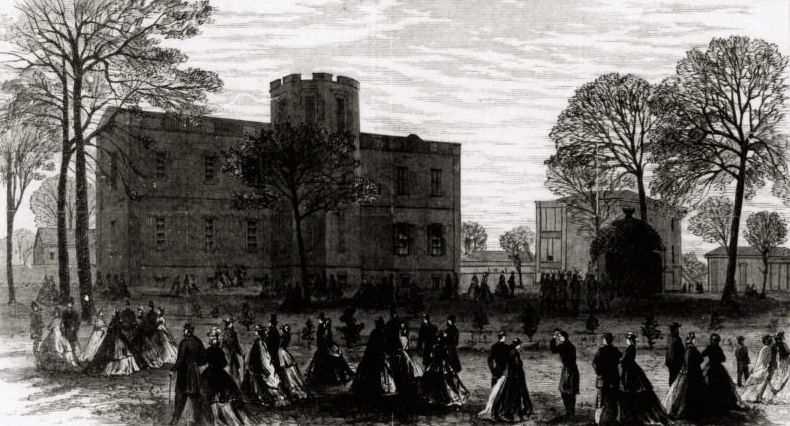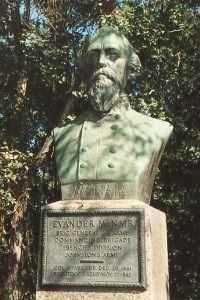|
4th Arkansas Infantry Battalion
The 4th Battalion, Arkansas Infantry was an infantry Battalion of the Confederate States Army during the American Civil War. The battalion served in the same brigade and was later consolidated with the 4th Arkansas Infantry Regiment, but units began as completely separate and unrelated organizations. Organization 4th Infantry Battalion was organized at Little Rock, Arkansas, on November 10, 1861, with five companies, from Clark, Prairie, Pulaski and White counties. The battalion was composed of the following companies:.Gerdes, Edward G.," 4TH BATTALION ARKANSAS INFANTRY", Edward G. Gerdes Civil War Page, Accessed 20 May 2012, http://www.couchgenweb.com/civilwar/4btninf_f&s.html * Company A, the "Bayou Metre Hornets", later renamed the "Turnbull Guards" from Pulaski County, commanded by Captain Thomas F. Murff. * Company B, the "McKeever Guards", from Prairie County, commanded by Captain Thomas J. Payne. * Company C, from Clark County, commanded by Captain Samuel O. Cloud. * Comp ... [...More Info...] [...Related Items...] OR: [Wikipedia] [Google] [Baidu] |
Confederate States Of America
The Confederate States of America (CSA), commonly referred to as the Confederate States or the Confederacy was an unrecognized breakaway republic in the Southern United States that existed from February 8, 1861, to May 9, 1865. The Confederacy comprised U.S. states that declared secession and warred against the United States during the American Civil War: South Carolina, Mississippi, Florida, Alabama, Georgia, Louisiana, Texas, Virginia, Arkansas, Tennessee, and North Carolina. Kentucky and Missouri also declared secession and had full representation in the Confederate Congress, though their territory was largely controlled by Union forces. The Confederacy was formed on February 8, 1861, by seven slave states: South Carolina, Mississippi, Florida, Alabama, Georgia, Louisiana, and Texas. All seven were in the Deep South region of the United States, whose economy was heavily dependent upon agriculture—particularly cotton—and a plantation system that relied upon enslaved ... [...More Info...] [...Related Items...] OR: [Wikipedia] [Google] [Baidu] |
Company H, 1st Tennessee Heavy Artillery
A company, abbreviated as co., is a legal entity representing an association of people, whether natural, legal or a mixture of both, with a specific objective. Company members share a common purpose and unite to achieve specific, declared goals. Companies take various forms, such as: * voluntary associations, which may include nonprofit organizations * business entities, whose aim is generating profit * financial entities and banks * programs or educational institutions A company can be created as a legal person so that the company itself has limited liability as members perform or fail to discharge their duty according to the publicly declared incorporation, or published policy. When a company closes, it may need to be liquidated to avoid further legal obligations. Companies may associate and collectively register themselves as new companies; the resulting entities are often known as corporate groups. Meanings and definitions A company can be defined as an "artificial per ... [...More Info...] [...Related Items...] OR: [Wikipedia] [Google] [Baidu] |
Arkansas In The American Civil War
During the American Civil War, Arkansas was a Confederate state, though it had initially voted to remain in the Union. Following the capture of Fort Sumter in April 1861, Abraham Lincoln called for troops from every Union state to put down the rebellion, and Arkansas and several other states seceded. For the rest of the civil war, Arkansas played a major role in controlling the Mississippi River, a major waterway. Arkansas raised 48 infantry regiments, 20 artillery batteries, and over 20 cavalry regiments for the Confederacy, mostly serving in the Western Theater, though the Third Arkansas served with distinction in the Army of Northern Virginia. Major-General Patrick Cleburne was the state's most notable military leader. The state also supplied four infantry regiments, four cavalry regiments and one artillery battery of white troops for the Union and six infantry regiments and one artillery battery of " U.S. Colored Troops." Numerous skirmishes as well as several signific ... [...More Info...] [...Related Items...] OR: [Wikipedia] [Google] [Baidu] |
List Of Arkansas Civil War Confederate Units
This is a list of Arkansas Civil War Confederate Units, or military units from the state of Arkansas which fought for the Confederacy in the American Civil War. The list of Union units is shown separately. Like most states, Arkansas possessed a prewar Militia organization, which consisted of seventy one regiments, organized into eight brigades, and divided into two divisions. In addition to its standard militia regiment or regiments, each county was authorized to create up to four Volunteer Militia Companies. While none of the prewar militia regiments were enrolled into Confederate service, many of the existing Volunteer Militia Companies were enrolled into new volunteer regiments. Other new Volunteer Companies were raised with no connection to the prewar militia. Immediately following secession, the State Military Board began organizing regiments of State Troops. Many of these regiments were eventually transferred into Confederate Service. Some Volunteer Regiments were organiz ... [...More Info...] [...Related Items...] OR: [Wikipedia] [Google] [Baidu] |
31st Arkansas Infantry Regiment
31 (thirty-one) is the natural number following 30 and preceding 32. It is a prime number. In mathematics 31 is the 11th prime number. It is a superprime and a self prime (after 3, 5, and 7), as no integer added up to its base 10 digits results in 31. It is a lucky prime and a happy number; two properties it shares with 13, which is its dual emirp and permutable prime. 31 is also a primorial prime, like its twin prime, 29. 31 is the number of regular polygons with an odd number of sides that are known to be constructible with compass and straightedge, from combinations of known Fermat primes of the form 22''n'' + 1. 31 is the third Mersenne prime of the form 2''n'' − 1. It is also the eighth Mersenne prime exponent, specifically for the number 2,147,483,647, which is the maximum positive value for a 32-bit signed binary integer in computing. After 3, it is the second Mersenne prime not to be a double Mersenne prime. 127, which is the 31st prime number, i ... [...More Info...] [...Related Items...] OR: [Wikipedia] [Google] [Baidu] |
Kirby Smith
General Edmund Kirby Smith (May 16, 1824March 28, 1893) was a senior officer of the Confederate States Army who commanded the Trans-Mississippi Department (comprising Arkansas, Missouri, Texas, western Louisiana, Arizona Territory and the Indian Territory) from 1863 to 1865. Prior to the American Civil War, Smith served as an officer of the United States Army. Smith was wounded at First Bull Run and distinguished himself during the Heartland Offensive, the Confederacy's unsuccessful attempt to capture Kentucky in 1862. He was appointed as commander of the Trans-Mississippi Department in January 1863. The area included most actions east of the Rocky Mountains and west of the Mississippi River. In 1863, Smith dispatched troops in an unsuccessful attempt to relieve the Siege of Vicksburg. After Vicksburg was captured by the Union in July, the Trans-Mississippi Department was cut off from the rest of the Confederacy, and became virtually an independent nation, nicknamed "Kirby Sm ... [...More Info...] [...Related Items...] OR: [Wikipedia] [Google] [Baidu] |
1st Arkansas Light Artillery
The 1st Arkansas Light Artillery, originally known as the Fort Smith Artillery (1861), was an artillery battery of the Confederate States Army that served during the American Civil War. The unit was actually a pre-war volunteer militia company which was activated as part of the Arkansas State Troops and mustered out of state service following the Battle of Wilson's Creek. The unit immediately re-organized and re-enlisted for Confederate service. The unit spent the majority of the war in the western theater, fighting as part of the Confederate Army of Tennessee. The unit is also known as Reid's Battery, Provence's Battery, Humphreys' Battery and finally Rivers' Battery. Organization Captain John G. Reid was elected as commander of a volunteer militia company of the 51st Militia Regiment, Sebastian County, Arkansas, on September 27, 1860. The battery was originally identified simply as the "Independent Artillery" but was later styled the "Fort Smith Battery" or the "Fort Smith Art ... [...More Info...] [...Related Items...] OR: [Wikipedia] [Google] [Baidu] |
13th Arkansas Infantry Regiment
The 13th Arkansas Infantry (1861–1865) was a Confederate Army infantry regiment during the American Civil War. Organized mainly from companies, including several prewar volunteer militia companies, raised in northeastern Arkansas, the regiment was among the first transferred to Confederate Service, and spent virtually the entire war serving in Confederate forces east of the Mississippi River. After the unit sustained heavy casualties during the Battle of Murfreesboro, the unit spent most of the rest of the war field consolidated with the 13th Arkansas Infantry Regiment, to form the 5th/13th Arkansas Infantry Regiment. Organization The 13th Arkansas was formally organized on July 29, 1861, at Camp Ground in Greene County, Arkansas, with about 1,000 men. The companies (less Co. K) mustered into Confederate service at Harrisburg, Arkansas, on July 23, 1861. Company K, the "Erin Guards," was from St. Louis, Missouri; the rest of the companies were from northeast Arkansas. Colonel A ... [...More Info...] [...Related Items...] OR: [Wikipedia] [Google] [Baidu] |
2nd Arkansas Mounted Rifles
The 2nd Arkansas Mounted Rifles (1861–1865) was a Confederate Army infantry regiment that served during the American Civil War. Raised in 1861, the regiment consisted of nine companies, which were drawn from various counties in Arkansas. Throughout the course of the war, the 2nd Arkansas Mounted Rifles fought in a number of battles, including those at Wilson's Creek and Pea Ridge, and participated in a number of campaigns such as Tullahoma, Atlanta and the Carolinas. The regiment's final battle came at Bentonville in March 1865 after which its remaining personnel were consolidated into the 1st Arkansas Consolidated Mounted Rifles. Organization The 2nd Arkansas Mounted Rifles was organized in the summer of 1861, with James M. McIntosh appointed as colonel. Other appointments upon establishment included: Ben T. Embry, lieutenant colonel; Brown, major; W. D. DeBerry, surgeon; W. A. C. Sayle, assistant surgeon. The regiment was inducted into Confederate Service on June 15, ... [...More Info...] [...Related Items...] OR: [Wikipedia] [Google] [Baidu] |
1st Arkansas Mounted Rifles
1st Arkansas Mounted Rifles (1861–1865) was a Confederate States Army cavalry regiment during the American Civil War. The unit was formed as a mounted infantry regiment, but was dismounted in the spring of 1862 and remained dismounted for the remainder of the war. The unit participated in the earliest battles in the western theater at Wilson's Creek and surrendered with the remnants of the Army of Tennessee in North Carolina in April 1865. Formation At the outbreak of the Civil War, Arkansas, formed some 48 infantry regiments, and a number of cavalry units. With the exception of the 3rd Arkansas Infantry Regiment, all of the Arkansas units would sign one year enlistments, thus leading to assignments in what was referred to as the "western theater", due to most of the large scale battles being fought in the east. The 1st Arkansas Mounted Rifles would sign one year enlistments, then later would sign a "three year or the duration of the war" extension. First organized in Little ... [...More Info...] [...Related Items...] OR: [Wikipedia] [Google] [Baidu] |
Army Of Tennessee
The Army of Tennessee was the principal Confederate army operating between the Appalachian Mountains and the Mississippi River during the American Civil War. It was formed in late 1862 and fought until the end of the war in 1865, participating in most of the significant battles in the Western Theater. History 1862 The army was formed on November 20, 1862, when General Braxton Bragg renamed the former Army of Mississippi and was divided into two corps commanded by Leonidas Polk and William J. Hardee. A third corps was formed from troops from the Department of East Tennessee and commanded by Edmund Kirby Smith; it was disbanded in early December after one of its two divisions was sent to Mississippi. The remaining division was assigned to Hardee's corps while Kirby Smith returned to East Tennessee. The army's cavalry was consolidated into a single command under Joseph Wheeler. The army's first major engagement under its new name took place against the Army of the Cumberland on ... [...More Info...] [...Related Items...] OR: [Wikipedia] [Google] [Baidu] |
Evander McNair
Evander McNair (April 15, 1820 – November 13, 1902) was a brigadier general in the Confederate States Army during the American Civil War. Early life Evander McNair was born at Laurel Hill in Scotland County, North Carolina. His parents moved to Simpson County, Mississippi soon after his birth. In his early twenties McNair opened a mercantile business in Jackson, Mississippi. During the Mexican War McNair joined the 1st Mississippi Rifles under the command of Colonel Jefferson Davis, who would later become President of the Confederacy. In 1856 McNair moved to Washington, Arkansas, and continued his business there until Arkansas seceded from the Union. McNair raised seven companies of infantry which was augmented with other volunteers and designated the 4th Arkansas Infantry. Military service Evander McNair became colonel of the 4th Arkansas Infantry Regiment on August 17, 1861. He led his unit into battle first at the Battle of Wilson's Creek in southwest Missouri and late ... [...More Info...] [...Related Items...] OR: [Wikipedia] [Google] [Baidu] |






